One of the reasons stated for the size of the proposed Blue House roundabout was extra traffic generated by new housing developments to the west and north of the city. Planning approval is currently being sought from North Tyneside Council for a development of 238 new houses on Gosforth Business Park, just off the A189 approximately one mile north of Haddricks Mill. This development, and in particular decisions made relating to its layout and design, will directly influence the volume of traffic through Haddricks Mill and Blue House junctions.
What did we find when we looked at this proposal?
- Unrealistic traffic estimates
- No mention of the nearby Air Quality Management Area in the Transport Assessment for the planning application
- A cycle lane/footway used as a car park and a 40mph A Road with a narrow pavement both described as being part of a ‘good standard footway and cycle network’
- Street layouts that add unnecessary distance to walking and cycling journeys, and
- Prospective residents being advised to store cycles in their gardens.
Based on this assessment, our judgement is that this application should be rejected because of the likely severe impact on public heath resulting from extra vehicle traffic in the South Gosforth Air Quality Management Area.
We look at these issues below, and highlight some simple low-cost changes to ensure that walking and cycling are not only possible but are also attractive options, giving people a real choice about how they travel.
Please do note that there are other issues relating to this proposal, outside the remit of SPACE for Gosforth, that may separately cause this application to be rejected. For example, the Natural History Society of Northumbria has set out objections relating to the impact on Gosforth Park Nature Reserve. Further comments can be viewed on the North Tyneside Council planning website.
You can comment on this planning application here.
Traffic Estimates
The Transport Assessment submitted by Persimmon Homes sets out the number of additional journeys the developer estimates will be generated and how these will be made.
According to section 5.3 of this document, the development will generate 307 trips in the morning peak (8-9am) and 339 trips in the evening peak (4-5pm). These figures are calculated using the TRICS database, which is a national standard for estimating the number of journeys people will make.
This has been broken down by travel mode using the split of the nearby Longbenton estate, which has high public transport usage, being located near to Longbenton Metro station, and a high proportion of pedestrian journeys, no doubt as a result of its proximity to the Benton Park View government employment site and the Freeman Hospital. This would suggest that vehicle trips will be 49% of the total, however we feel this is unlikely to replicated at the proposal site which is, at its nearest, a 1.3 mile walk to Longbenton Metro.
More realistically, with the proposal as it is, the number of vehicle journeys is likely to be closer to 64% (*the figure for the area immediately to the north). 64% of 307 is 196 vehicles in the morning peak.
If all this traffic were to drive south through Haddricks Mill, which is the most likely route, we estimate this would represent in the order of a *29% increase in traffic driving south along that route, which would be a very significant impact, especially given Haddricks Mill is part of an Air Quality Management Area.
While there is a regular bus service to the city centre within 500m of most of the new houses, this is no better than the service in the area immediately to the north. In addition, as a result of the proposed site layouts, the walk from the bus stop to the house locations is not overlooked so there is a potential safety issue for people who use it, and the walking routes themselves are also lengthened as a result of the proposed street designs.
Proposed Mitigations
The Objectives in the application’s “Design and Access Statement – Gosforth Business Park – 19 July 2016” include an objective ‘To maintain sustainability ideals and maximise opportunities for sustainable modes of transport.‘ This is in line with North Tyneside Council’s own policy to “...actively manage patterns of growth to make the fullest possible use of public transport, walking and cycling, and focus significant development in locations which are or can be made sustainable”.
Figure 4 in the Transport Assessment (reproduced below) gives the possible walking and cycling routes based on a 2km walk or a 5km cycle. These distances are actually understated compared to other applications we have seen, in particular for cycling where longer commutes are easily possible where appropriate safe routes exist. Creating a choice of travel options though is more than just distance. It is also important to consider whether the routes shown in Figure 4 are attractive options.
Blocked or Unviable Walking and Cycling Routes
Gosforth Park Way does have a marked off-road cycle path however currently this is unusable because of parked cars along that route (the cycle lane is where the cars on the left of the photograph below are parked). The right hand pavement as shown is also blocked by parked cars. This is also the walking route to the nearest bus stop to the application site.
Once off the site, the most direct route towards the City Centre (marked on the cycle map as an advisory route) is a busy 40mph A road with no continuous provision for cycling. It is unlikely that any residents would wish to use this route, and certainly not for escorting children to school.
Further north, where Figure 4 shows a walking route, the A189 becomes a 50mph dual carriageway with no pavement.
Adding Distance to Walking and Cycling Journeys
Within the proposed site the Transport Assessment (section 4.13) suggests it will be ‘providing direct connections to origins and destination within the developable area and beyond which are permeable, safe and reflect desire lines of movement‘. This is important as the choices people make to walk and cycle are known to be sensitive to length of the journey.
Looking at the proposed layout however (see below), walking and cycling routes are constrained to be the same as vehicle access and anyone wishing e.g. to walk south to the nearest bus stop, will have to walk a considerable extra distance to exit the development before they even reach the potentially blocked footway on Gosforth Park Way (the road between cells 2 & 3). Nor are there any links to outside the site e.g. from Cell 3 to Salters’ Lane on the left of the picture, which would be a useful route for anyone wishing to access the cycle way there or to go to Gosforth Park.
Lack of Cycle Storage
The Design and Access Statement also says that ‘Secure external cycle and general storage provision will be enabled in properties provided with a garage. In other instances, private gardens are of sufficient size to ensure that adequate external storage can be accommodated.‘ I.e. a garage (also needed for a car) or the garden.
Persimmon Homes have also submitted a travel plan to “increase awareness of sustainable travel options and to encourage their use“, however this will not be able to make up for any short-comings of the scheme as a result of its current design and layout.
Potential Improvements
Many of these issues can be resolved with amendments to the design to prioritise and encourage walking and cycling. These are our recommendations.
- Parking issues on Gosforth Park Way need resolving and good quality footway and cycleways provided. Two-way cycle ways are generally required to be at least 3m wide and should take priority over side roads. If necessary these should be provided on land currently part of this application.
- Walking and cycling routes from each of cells 1, 2 & 3 should be provided so that residents have easy and direct access onto Gosforth Park Way at both north and south ends of each cell.
- Additional walking and cycling routes should be provided from cells 1 & 3 to Salters’ Lane and, if possible, from cell 2 to adjacent industrial sites.
- All walking and cycling routes should be well-lit and the site layout should ensure that, so far as possible, people using these routes (including Gosforth Park Way) feel safe even if walking them alone and at night. This might require further changes to Gosforth Park Way itself.
- Specific storage for bicycles should be provided in convenient locations at the front of the houses, for example in shared locked units such as the Lambeth Bikehangar (shown below).
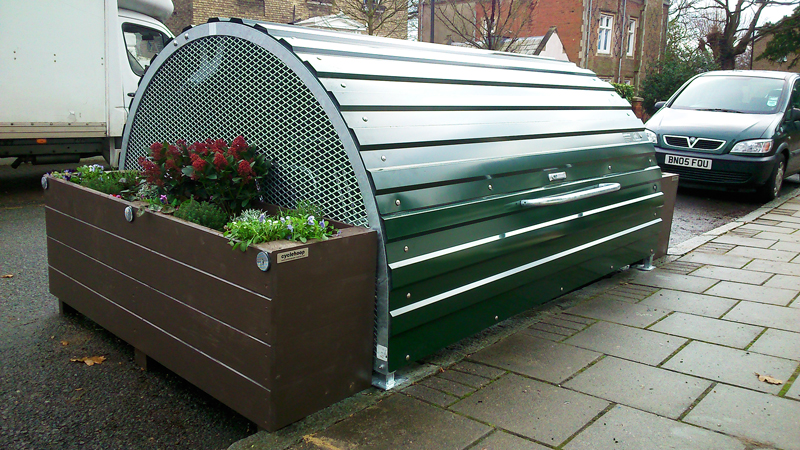
- The developer should provide secure cycle storage adjacent to the nearest bus stops and at Longbenton Metro for use of residents to provide a further combined cycle / public transport travel option.
- The developer should pay for further improvements to Salters’ Lane to provide good quality continuous walking and cycling routes to link to the Killingworth Road footway / cycle lane proposed as part of the recent Haddricks Mill consultation. These should be built at the same time as or prior to the proposed development.
- North Tyneside Council and the developer should select appropriate direct walking and cycling routes to link the application site to West Moor and to Killingworth and ensure these are upgraded to a standard where all ages and abilities would feel safe using it. (For standards see the SPACE for Gosforth post Lots of children want to cycle…)
- The developer should consult with businesses on Gosforth Business Park and Balliol Business Park to agree further measures that would help reduce vehicle traffic to Gosforth Business Park to offset the increased traffic as a result of this development. This could include the introduction of paid parking along Gosforth Park Way as a way of creating a fund to pay for these further measures.
Comments must be made by 14 September 2016
You can view the planning application here, or search North Tyneside Council’s planning website using the reference 16/01304/FUL. Comments must be made by Wednesday 14 September 2016.
Notes on traffic estimates
Mode share for cars for North Tyneside 019C Lower Layer Super Output Area, the area including the proposed development and used in the Transport Assessment prepared by Milestone Transport Planning for Persimmon Homes is 49%. Current housing in that area is at the south end close to Longbenton Metro and the Benton Park View government site. The equivalent figure for North Tyneside 014D Lower Layer Super Output Area, the area immediately north of the development, is 64% of trips by car.
The 29% increase in traffic along Salters’ Lane is based on the average weekday total vehicles per day from the TADU website, which is 16,643. We have assumed that half of this, 8,321 vehicles, are travelling south over the day and that 8% of that total, 666 vehicles, travel south between 8 and 9am. 8% is derived from traffic profiles from a similar route. 196 extra vehicles vs 666 current vehicles represents an increase of 29%.


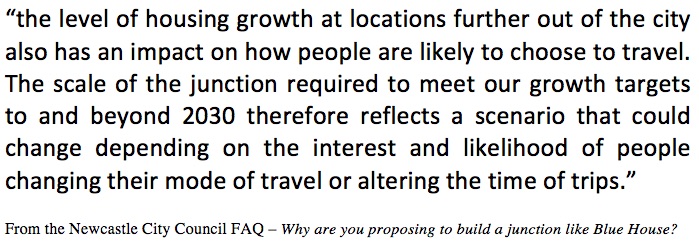
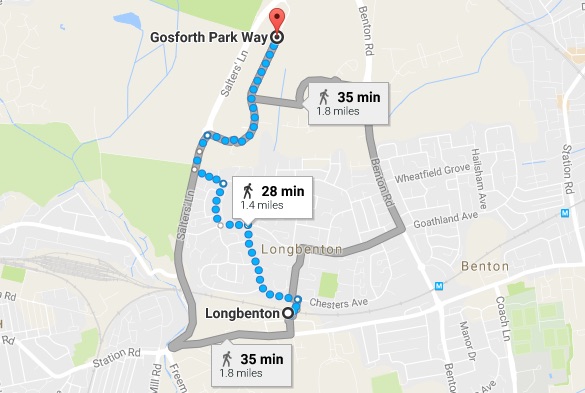
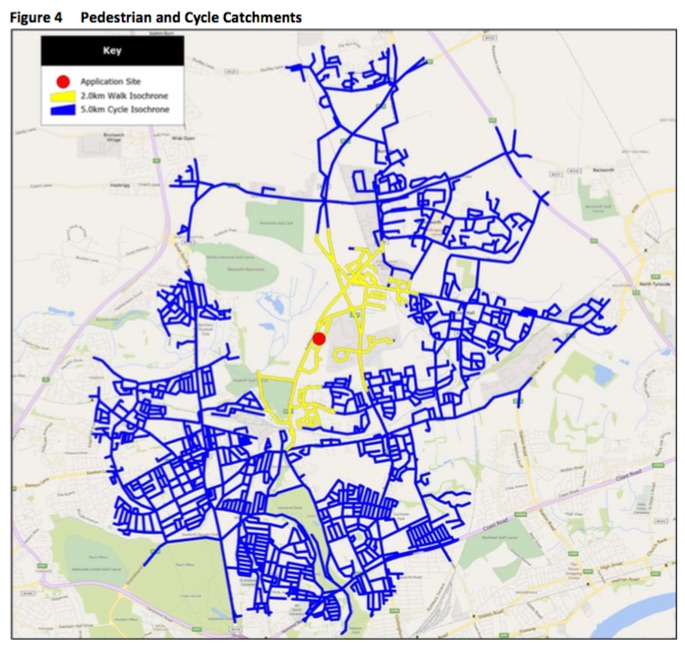
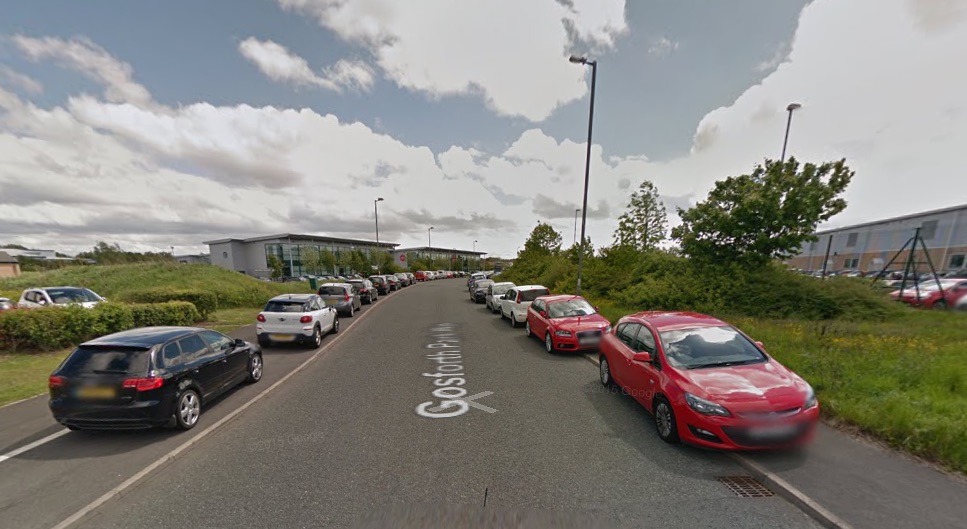
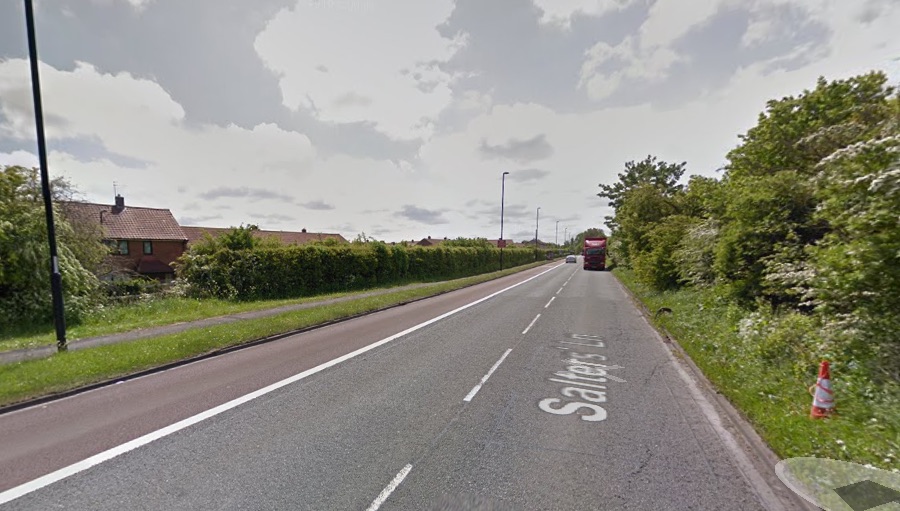

All three MP’s in Newcastle strongly opposed the Blue House Roundabout plans. If housing developments like this are the root cause of such horrendous junction proposals then we should encourage MP’s to oppose this plan as well ( or at least rethink the traffic implications)?
Hi Nick, Thanks for the comment. We have tweeted this post to our MPs but if you are able to raise it with them as well that would be great.
The traffic analysis above does not take into account the proposed development of the former Greggs factory sited in Gosforth industrial estate. Thats another few hundred cars heading out either up Criston Rd, or Salters bridge, if a metro crossing is included.
Thanks for highlighting this application – I did not know about the planned development, despite living in Longbenton, just south of it. I’m not sure who the council actually informed…
Following this post SPACE for Gosforth wrote to the Persimmon director who chairs their Corporate Responsibility Committee. Their response was as follows:
Thank you for your e-mail correspondence of 6th September 2016 in connection with the above Planning Application submitted by the North East operating business on behalf of Persimmon Homes Ltd.
As you state, Persimmon Homes do take on-board social, environmental and economic issues when co-ordinating Planning Applications with external specialist consultants and local authority departments to ensure suitable solutions are discussed.
I have raised your particular concerns with the Group Planning Director who was aware of the development planning application and he has confirmed that points raised by yourself and SPACE for Gosforth will be addressed and considered through the planning process by the operating business with a response confirming the matters issued to the local authority and yourselves on these points.
Thank you for your time in bringing your concerns to my attention as the Chair of the CR committee and please be assured that your environmental concerns are being given attention as part of the planning process.